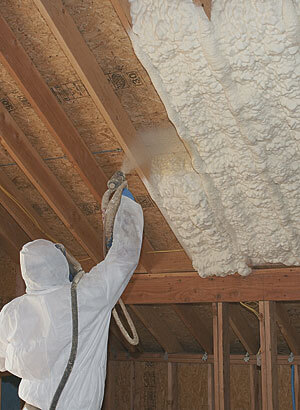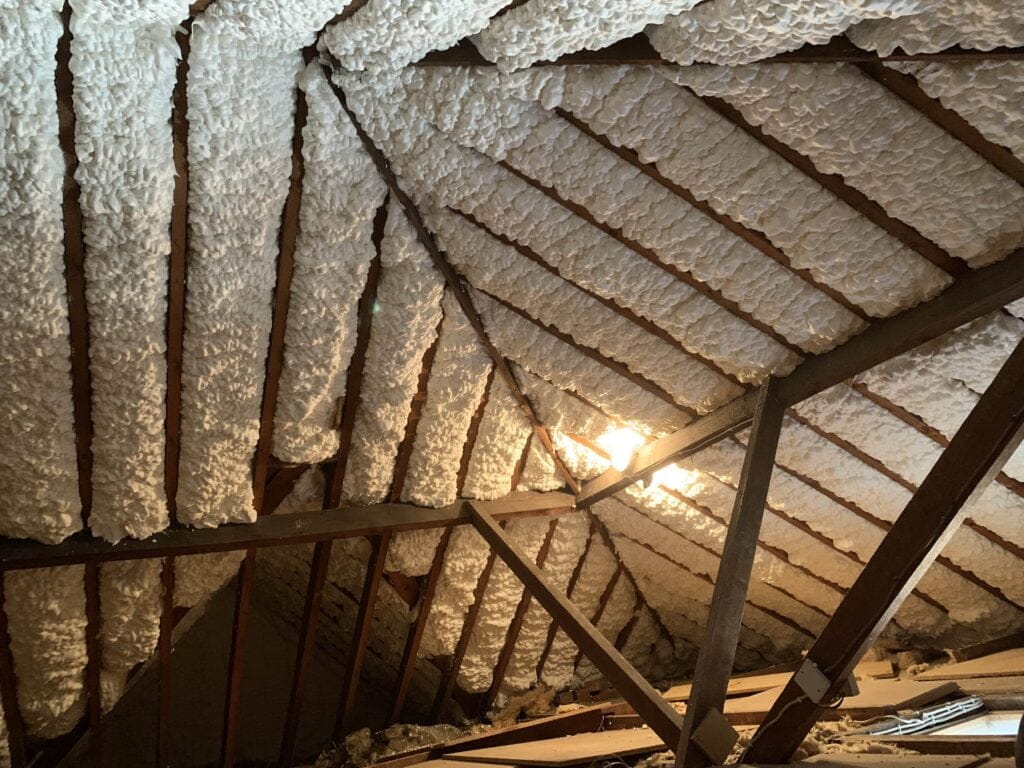How Spray Foam Can Boost Power Performance in Any Structure
Spray foam insulation has actually become a pivotal service for boosting power efficiency throughout different building kinds. By creating an airtight seal that lessens air leak, it successfully manages interior climates while dramatically decreasing cooling and heating costs. Furthermore, its remarkable R-value and moisture-resistant homes add to long-lasting power savings and boosted structure longevity. As residential or commercial property proprietors increasingly seek sustainable solutions, the ramifications of spray foam insulation expand past plain energy savings. The complete extent of its benefits, nevertheless, warrants a better examination of how it can transform power administration approaches in both business and property setups.
Recognizing Spray Foam Insulation
Spray foam insulation is increasingly recognized for its superior thermal efficiency and adaptability in different applications. Made up largely of polyurethane, this insulation product is applied as a liquid that increases upon call, filling spaces and creating a smooth obstacle. This unique home allows spray foam to adjust to uneven surface areas, making it a suitable selection for both domestic and commercial frameworks.

Application of spray foam insulation is usually performed by trained specialists utilizing specialized tools, guaranteeing ideal efficiency and safety - Spray Foam. The healing process is rapid, enabling for fast installation and marginal interruption. Consequently, spray foam insulation is increasingly being employed in new construction and retrofitting jobs due to its capacity to enhance structural stability while improving total energy efficiency in structures
Advantages of Power Efficiency
Energy effectiveness plays an essential duty in decreasing functional expenses and reducing ecological effect throughout numerous sectors. By optimizing energy use, homeowners and companies can attain significant savings on energy costs, which directly improves financial performance. Effective power consumption implies much less reliance on fossil gas, thereby adding to a decrease in greenhouse gas emissions and promoting an extra sustainable atmosphere.
Furthermore, energy-efficient buildings often experience enhanced residential or commercial property values. As energy expenses climb and sustainability comes to be a top priority for consumers, properties with boosted energy efficiency features are a lot more eye-catching on the market. This fad encourages financial investment in energy-saving technologies, which can even more drive advancement and economic growth.
Along with environmental and financial advantages, energy efficiency can likewise boost the overall convenience and health and wellness of interior spaces. Appropriate insulation and effective home heating and air conditioning systems help keep regular temperatures, decreasing drafts and humidity levels, which consequently can result in far better indoor air top quality.
Eventually, the benefits of energy performance expand past immediate cost savings, promoting a durable economy, advertising ecological stewardship, and enhancing the lifestyle for residents in any structure.
Just How Spray Foam Works
Typically used as a liquid, spray foam increases quickly upon contact with surfaces, developing a strong barrier that properly secures splits and voids. This unique home results from its chemical composition, primarily consisting of isocyanates and polyols, which respond when blended to create a foam that fills up voids and sticks to different materials, including metal, concrete, and timber.
Once used, the foam broadens to a number of times its original volume, making sure a tight seal that stops air leakage. This process substantially minimizes thermal connecting, which happens when warm transfers through products, bring about energy loss. The foam's high R-value, an action of thermal resistance, adds to enhanced insulation by decreasing warmth transfer in between the exterior and interior settings.
Furthermore, spray foam is immune to moisture and bugs, additionally enhancing its effectiveness in preserving power efficiency. Its application can be tailored to various areas, including attics, walls, and crawl rooms, maximizing insulation across a building. Spray Foam. Overall, the ingenious style and application method of spray foam make it an effective solution for boosting energy performance in any type of framework, causing minimized power expenses and a much more lasting built setting

Applications in Numerous Buildings
Many applications of spray foam insulation can be found throughout various building kinds, improving power efficiency and convenience. In domestic homes, spray foam is usually made use of in attics and wall surfaces to create a seamless obstacle versus air leakages, significantly minimizing home heating and cooling needs. This application is specifically valuable in older homes, where conventional insulation might be inadequate.
In industrial structures, spray foam insulation is put on roof systems and outside wall surfaces, which aids to boost thermal efficiency and safeguard against moisture intrusion. Its light-weight nature makes it a suitable selection for retrofitting existing structures without including considerable weight. In addition, spray foam can be made use of in Discover More Here industrial settings to insulate pipes and tank, maintaining temperature control for sensitive materials.
Institutional structures, such as schools and hospitals, take advantage of spray foam insulation by ensuring a constant interior climate that sustains owner comfort and health and wellness. The adaptability of spray foam permits it to adjust to various building sizes and shapes, making it a recommended option for architects and builders looking for efficient insulation services. On the whole, spray foam insulation acts as an essential part in attaining energy-efficient buildings across all industries.
Long-Term Price Savings
Spray foam insulation provides considerable long-term expense savings for structure proprietors and passengers by lowering power consumption and lowering energy costs. By giving a premium air seal, spray foam decreases the seepage of outdoors air, thus enhancing the thermal efficiency of a structure. This leads to much more efficient website here heating and cooling procedures, which can result in substantial decreases in energy prices gradually.
Along with prompt cost savings on energy expenses, the toughness and durability of spray foam insulation add to its financial advantages. Unlike conventional insulation materials, which may sag, settle, or deteriorate, spray foam keeps its effectiveness for years, minimizing the demand for frequent substitutes or repairs. This long life converts to reduce maintenance costs and much less disturbance for passengers.
Furthermore, structures geared up with spray foam insulation frequently appreciate a rise in building worth, making them more attractive to possible customers or renters. As energy effectiveness becomes significantly prioritized, buildings with efficient insulation remedies attract attention on the market. Inevitably, the assimilation of spray foam insulation not only improves comfort however also stands for a strategic financial investment that generates considerable financial advantages over the lengthy term.
Verdict
In conclusion, spray foam insulation acts as an important part in enhancing power efficiency throughout diverse structure types. Its ability to create a smooth barrier against air leakage, incorporated with moisture-resistant homes and high r-values, dramatically decreases power usage and associated prices. The implementation of spray foam not just contributes to regular indoor temperature levels however also enhances residential property worth, emphasizing its function as a sensible investment for both domestic and commercial buildings.
Spray foam insulation has actually emerged as a pivotal solution for enhancing energy performance across numerous structure types. Spray Foam. As a result, spray foam insulation is significantly being used in new building and retrofitting tasks due to its capacity to improve architectural stability while boosting general energy this link performance in buildings
Generally, the ingenious layout and application method of spray foam make it a reliable service for boosting energy efficiency in any type of structure, leading to reduced energy costs and an extra sustainable constructed atmosphere.
Countless applications of spray foam insulation can be found throughout various structure types, boosting energy effectiveness and comfort.In verdict, spray foam insulation serves as an essential element in improving power effectiveness across diverse structure types.
Comments on “Comparing Spray Foam to Traditional Insulation: Which Is Much better?”